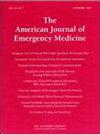Inequities in imaging: The association between patient demographics and use of point-of-care ultrasound in the ED
IF 2.2
3区 医学
Q1 EMERGENCY MEDICINE
引用次数: 0
Abstract
Background
Point-of-care ultrasound (POCUS) is a key diagnostic test in the emergency department (ED), especially in hypotensive patients. While bias exists throughout the health care system, it is unknown if these disparities also influence the use of POCUS. This study aimed to determine whether POCUS use in ED patients with hypotension varies based on demographic factors.
Methods
This was a retrospective analysis of visits to five EDs over five years. Adult patients with hypotension (systolic blood pressure less than 90 mmHg) were included. The primary outcome was whether a critical POCUS exam was performed. Critical POCUS included cardiac, thoracic, deep vein thrombosis, abdominal fluid (FAST), or aortic exams. We constructed a generalized linear mixed model to examine differences in the odds of receiving a critical POCUS exam between demographic groups.
Results
There was no significant difference in the odds of receiving a critical POCUS exam between racial/ethnic groups. However, female patients (aOR: 0.74, 95 % CI [0.70–0.78]) and patients with public insurance (aOR: 0.92, 95 % CI [0.86–0.99]) had significantly lower odds of receiving POCUS compared to male patients and those with private insurance, respectively.
Conclusions
There was no significant difference in POCUS use between racial/ethnic groups in this cohort. However, female patients and those with public insurance were at lower odds of receiving a POCUS exam. Additional research is needed to explore the causes of these disparities.
成像不公平:急诊科患者人口统计学特征与即时超声使用之间的关系
背景:即时超声(POCUS)是急诊科(ED)的一项关键诊断测试,尤其是对低血压患者。虽然整个卫生保健系统存在偏见,但尚不清楚这些差异是否也影响POCUS的使用。本研究旨在确定POCUS在ED低血压患者中的应用是否因人口统计学因素而异。方法回顾性分析5年来5次急诊科就诊情况。包括有低血压(收缩压小于90mmhg)的成年患者。主要结果是是否进行了关键的POCUS检查。重症POCUS包括心脏、胸部、深静脉血栓、腹腔积液(FAST)或主动脉检查。我们构建了一个广义线性混合模型来检验不同人口统计学群体接受关键POCUS检查的几率差异。结果不同种族/民族患者接受关键POCUS检查的几率无显著差异。然而,女性患者(aOR: 0.74, 95% CI[0.70-0.78])和公共保险患者(aOR: 0.92, 95% CI[0.86-0.99])接受POCUS的几率分别显著低于男性患者和私人保险患者。结论该队列中不同种族/民族的POCUS使用无显著差异。然而,女性患者和有公共保险的患者接受POCUS检查的几率较低。需要进一步的研究来探索这些差异的原因。
本文章由计算机程序翻译,如有差异,请以英文原文为准。
求助全文
约1分钟内获得全文
求助全文
来源期刊
CiteScore
6.00
自引率
5.60%
发文量
730
审稿时长
42 days
期刊介绍:
A distinctive blend of practicality and scholarliness makes the American Journal of Emergency Medicine a key source for information on emergency medical care. Covering all activities concerned with emergency medicine, it is the journal to turn to for information to help increase the ability to understand, recognize and treat emergency conditions. Issues contain clinical articles, case reports, review articles, editorials, international notes, book reviews and more.

 求助内容:
求助内容: 应助结果提醒方式:
应助结果提醒方式:


